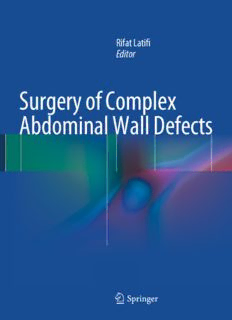
Surgery of Complex Abdominal Wall Defects PDF
Preview Surgery of Complex Abdominal Wall Defects
Rifat Latifi Editor Surgery of Complex Abdominal Wall Defects 123 Surgery of Complex Abdominal Wall Defects Rifat Lati fi Editor Surgery of Complex Abdominal Wall Defects Editor Rifat Lati fi , MD, FACS Department of Surgery The University of Arizona Tucson, Arizona USA Trauma Section, Department of Surgery Weill Cornell Medical College Hamad General Hospital Doha , Qatar ISBN 978-1-4614-6353-5 ISBN 978-1-4614-6354-2 (eBook) DOI 10.1007/978-1-4614-6354-2 Springer New York Heidelberg Dordrecht London Library of Congress Control Number: 2013939780 © Springer Science+Business Media New York 2013 This work is subject to copyright. All rights are reserved by the Publisher, whether the whole or part of the material is concerned, speci fi cally the rights of translation, reprinting, reuse of illustrations, recitation, broadcasting, reproduction on micro fi lms or in any other physical way, and transmission or information storage and retrieval, electronic adaptation, computer software, or by similar or dissimilar methodology now known or hereafter developed. Exempted from this legal reservation are brief excerpts in connection with reviews or scholarly analysis or material supplied speci fi cally for the purpose of being entered and executed on a computer system, for exclusive use by the purchaser of the work. Duplication of this publication or parts thereof is permitted only under the provisions of the Copyright Law of the Publisher’s location, in its current version, and permission for use must always be obtained from Springer. Permissions for use may be obtained through RightsLink at the Copyright Clearance Center. Violations are liable to prosecution under the respective Copyright Law. The use of general descriptive names, registered names, trademarks, service marks, etc. in this publication does not imply, even in the absence of a speci fi c statement, that such names are exempt from the relevant protective laws and regulations and therefore free for general use. While the advice and information in this book are believed to be true and accurate at the date of publication, neither the authors nor the editors nor the publisher can accept any legal responsibility for any errors or omissions that may be made. The publisher makes no warranty, express or implied, with respect to the material contained herein. Printed on acid-free paper Springer is part of Springer Science+Business Media (www.springer.com) To Dr. Stanley J. Dudrick, the father of modern surgical nutritional support, my mentor, teacher, and friend, who taught me reoperative complex surgery and how to care for most complex and dif fi cult surgical patients, and whose extraordinary personal attributes and professional, educational, and scienti fi c contributions will endure into future generations of surgeons all over the world. Foreword A surgeon can do more for the community by operating on hernia cases and seeing that his recurrence rate is low than he can by operating on cases of malignant disease. Sir Cecil Wakely, 1948, president of the Royal College of Surgeon Oh, if only it were that simple! Certainly, Sir Wakely was referring to inguinal and perhaps umbilical hernias in this well-known quotation from the middle of the last century. I wonder if at the time he could have imagined the true complexity of the problem: our limited understanding of the dynamic physiology of abdominal wall tension and the need for more re fi ned surgical techniques to manage abdominal wall defects. Perhaps most shocking of all to Sir Wakely might have been the ability for patients to withstand and survive catastrophic illness resulting in com- plex abdominal wall defects. Even as recently as 25 years ago, it was hard to believe that a patient who had lost integrity of the abdominal wall as a result of injury, abdominal sepsis, or gastroin- testinal failure could even survive, let alone return to functional status. However, with the evolu- tion of resuscitation, operation, and surgical critical care for patients with devastating abdominal injury and illness, a high survival rate is now a reality. With this, our ability to manage the atten- dant complications, including complex abdominal wall defects with and without intestinal fi stula, has improved dramatically. This has happened because the clinical circumstances have demanded it, and our zeal to improve care is no less ardent than that of Sir Wakely over a half century ago. The editor, Dr. Rifat Lati fi , and contributors to this work have produced what I believe is the quintessential and seminal resource on this vexing and challenging topic. S urgery of Complex Abdominal Wall Defects is the fi rst textbook of its kind to provide a comprehensive review of modern management of abdominal wall problems. It eloquently reviews the anatomy and physiology of the abdominal wall and the pathophysiology of abdominal wall defects. It pro- vides a valuable history of abdominal wall repair and then systematically provides the latest approach to operative repair, including preoperative preparation, acute management of the open abdomen, the approach to the hostile abdomen in the intermediate term, critical strategies in long-term reconstruction, and the full spectrum of special circumstances that arise along the way. Nowhere will you fi nd a more comprehensive and practical guide for the management of these patients. If nothing else, this text provides the fundamental context in which these prob- lems will be discussed and in which future advances are made. I commend the authors on this accomplishment, and I encourage the readers to pay close attention to the content. Herein lies the state-of-the-art surgical management for patients with complex abdominal wall defects. Sir Wakely would be proud to know how far the art and sci- ence of the approach to these patients have come. Greenville, NC, USA Michael F. Rotondo, MD, FACS vii Disclosure Dr. Rifat Lati fi is a speaker for LifeCell Corporation and has received a grant through International Virtual e-Hospital Foundation, a not-for-pro fi t organization that made possible administrative support and secretarial help for this book. ix
Description: